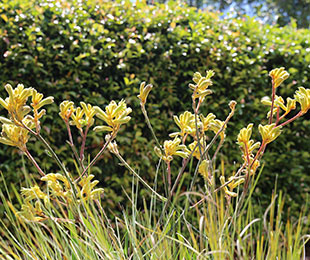Are you a landscape architect or designer looking for advice on mass planting? You may not have had a chance to learn about mass planting during your studies, or maybe you’ve simply forgotten.
Or maybe you’re just in the market for some new mass planting varieties to start specifying in your upcoming designs. Either way, in this article, we’re going to learn about some of the basic principles behind mass planting designs, as well as some of the best plant varieties you can specify.
What Is Mass Planting?
Mass planting is where plants are clustered in drifts or swathes to accentuate their collective impact rather than individual presence. This deliberate clustering strategy fosters a sense of harmony, rhythm, and purpose within the landscape design, elevating the overall aesthetic appeal.
The Advantages of Embracing Mass Planting:
- Visual Impact: Commanding attention and defining spaces with a bold and captivating visual display.
- Unity and Cohesion: Fostering a harmonious flow and consistency in design through repeated patterns.
- Simplicity and Elegance: Imparting a sense of order and sophistication, especially when utilizing single-species groupings.
- Ease of Maintenance: Streamlining upkeep efforts by managing large swathes of the same species efficiently.
- Habitat Creation: Supporting local wildlife and biodiversity conservation efforts by incorporating native species in mass plantings.
Strategic Employment of Mass Planting in Landscape Design:
- Creating Focal Points: Directing attention to specific areas or features within the landscape with strategically placed mass plantings.
- Defining Spaces: Delineating boundaries or softening transitions between different zones through well-executed mass planting schemes.
- Enhancing Prominence: Elevating the visibility of architectural elements or pathways by surrounding them with mass-planted vegetation.
Instances to Exercise Caution with Mass Planting:
- Confined Spaces: Small areas may not benefit from mass planting, potentially overwhelming the visual landscape.
- Invasive Species: Steering clear of non-native plants that could pose harm to local ecosystems. Remember that cultivated varieties of common “weedy” species (such as agapanthus, gazania, pennisetum, etc.) may not be as weedy as you think. Cultivars are bred for function, rather than seed virility.
- Variable Conditions: Being mindful of diverse soil and light conditions that may challenge the uniformity of mass planting designs. Planting the same variety in full sun as well as shady positions will influence how each plant performs.
Best Plant Varieties for Mass Planting
Of course, it’s not possible to cover every single plant that’s suitable for mass planting. Instead, we’re going to go over a few of the best genera of plants for mass planting and give a specific example for each one.
Lomandras
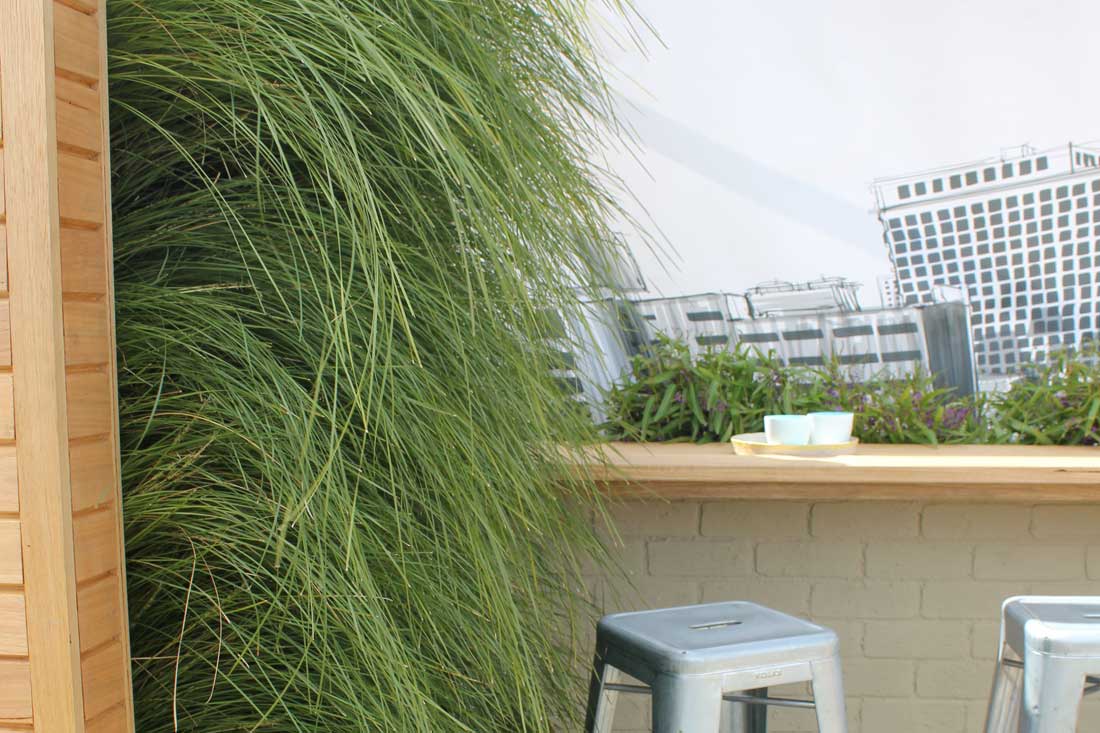
These strappy-leafed Australian native plants come in a range of heights, from compact ground covers to giant feature plants. They’re often drought-hardy, with some varieties also tolerating wet feet.
Tanika® Lomandra longifolia ‘LM300’ PBR is one of the most popular Australian native plants ever bred, and for good reason. It’s as tough as nails as long as it doesn’t sit in wet feet or humidity, and has soft evergreen foliage that looks amazing in mass planting schemes.
https://www.ozbreed.com.au/plant-ranges/strappy-leaf-plants/tanika-lomandra/
Dianellas

Dianellas, or Australian flax lillies, are another strappy native plant perfect for mass planting. They feature delicate purple or blue flowers on stalks which feed native buzz pollinators such as the blue-banded bee. These flowers become purple berries which feed a variety of local fauna.
Little Jess™ Dianella caerulea ‘DCMP01’ PBR is a compact variety with short canes that are hidden beneath the foliage after they’re spent, reducing the necessity for dead heading. This plant is an excellent option for playground soft fall as well.
https://www.ozbreed.com.au/plant-ranges/strappy-leaf-plants/little-jess-dianella/
Kangaroo Paws
Anigazanthos spp. are West Australian natives which usually prefer free-draining soils, and put on a spectacular show in spring with flowers varying from white to yellow to orange to pink, red, and purple.
Everlasting Mega Gold™ Anigozanthos hybrid ‘KP03’ is a variety that flowers for most of the year, unlike other varieties. It features spectacular yellow velvet flowers and can even tolerate the extreme humidity of northern QLD, although it won’t live as long as it does in non-humid climates.
https://www.ozbreed.com.au/plant-ranges/kangaroo-paws/everlasting-mega-gold/
Pig Face
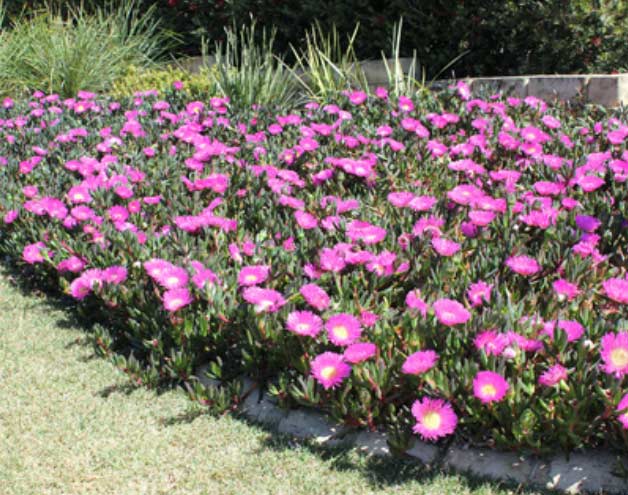
Pig faces, including our native Carpobrotus, are experts at surviving with minimal moisture on sand dunes where coastal salt and winds are present. They hold moisture in their succulent leaves, while their root systems are relatively unimpressive, and so they are not advised on slopes where they may slide down.
Aussie Rambler™ Carpobrotus glaucescens ‘CAR10’ PBR is a particularly good-looking and resilient variety which features abundant giant pink flowers. It’s also better in heavy soils than other pig faces.
Correas
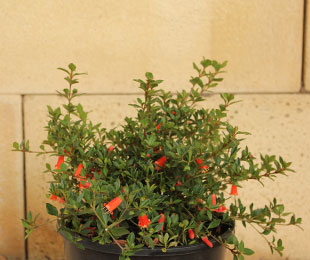
Some correas are too large for mass planting and are better for screening and topiary. However, prostrate and ground-covering correas are ideal for this purpose.
Fire Bells™ Correa pulchella ‘COR11’ PBR Intended is such an example. Featuring fiery orange-red flowers that appear in winter when few other plants are in flower, this plant excels in a mass-planting scenario. It’s adaptable to most soils, though it prefers a bit of drainage, it tolerates drought and frost and it requires minimal pruning to look its best.
Scaevola
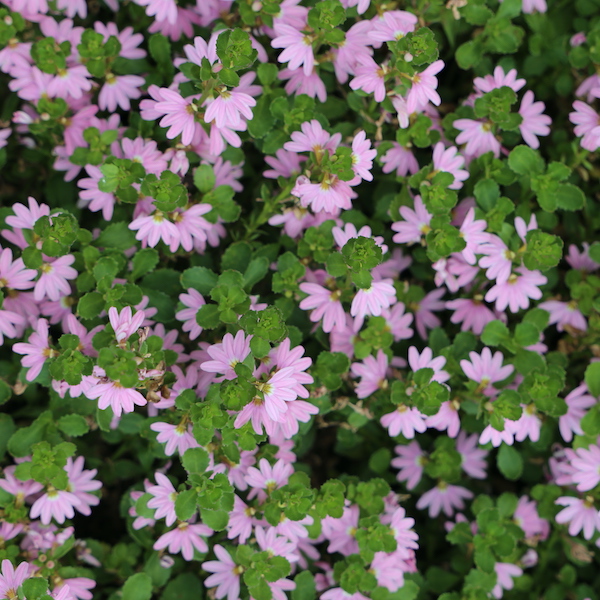
Fan flowers, also known as scaevola, are under-appreciated in Australian gardens, especially those with a native theme. They’re tough as nails, keep spreading to cover ground, and they have an extended flowering season.
Pink Fusion™ Scaevola spp. ‘PFS200’ PBR Intended is one of the most resilient plants ever bred. It thrives on roadsides with poor soils and still flowers spectacularly with its signature pink blooms. Unlike “wildflowers” such as paper daisies and yellow buttons, this variety will just keep on living year after year. We’ve tested it for 12 years and it just keeps going.
https://www.ozbreed.com.au/plant-ranges/native-shrubs-groundcovers/pink-fusion/
Myoporum
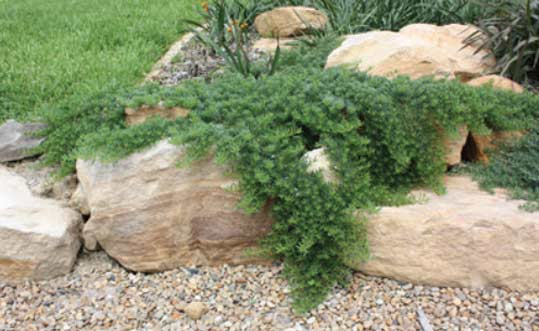
Another native ground cover that feeds our pollinators, myoporum is another excellent contender for mass planting.
Yareena™ Myoporum parvifolium ‘PARV01’ PBR is very drought and frost tolerant, and tolerates a wide range of soil types. This variety is longer-lived than others with clean foliage.
Westringias
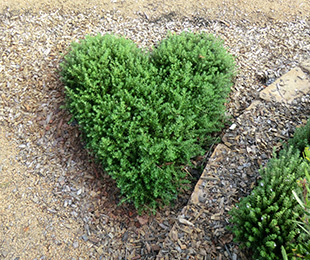
Westringias, or coastal rosemaries, come in a range of shapes and sizes. Some of the shorter and ground-covering varieties are perfect for mass planting, with flowers ranging from white to purple and blue. Some varieties will flower sporadically throughout the year, with the most vigorous flowering usually occurring in spring.
Low Horizon™ Westringia fruticosa ‘WES06’ PBR is a beautiful, drought-tolerant cultivar that’s dense and ultra-compact. It tolerates frost, and has handled NSW humidity well, though more testing is needed in QLD.
Gazanias
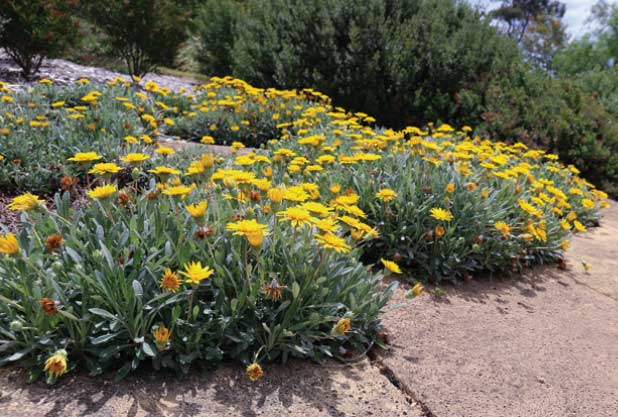
When we think of mass planting, there’s a good chance that small aster flowers like gazanias are what first comes to mind. These plants flower abundantly for most of the year, and they need minimal upkeep. However, just be careful because gazanias are typically quite weedy.
Double Gold™ Gazania hybrid ‘GT20’ PBR is a sterile variety that still gives us the showy colour we’re looking for, without the environmental risk that weeds pose. Tolerating frost and drought, this variety tolerates most soil types.
Aloes
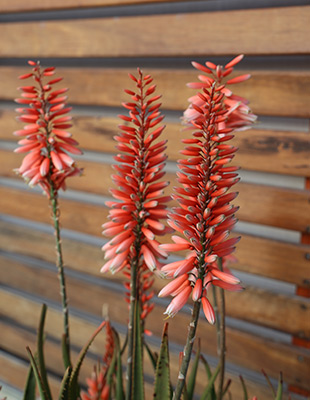
With their upright architectural spiky succulent foliage and showy flower stalks that appear in the cooler months, aloes are a low-maintenance garden’s perfect plant. Just because they aren’t native, doesn’t mean that our native birds, mammals and insects won’t make good use of their floral resources.
Mighty Coral™ Aloe hybrid ‘AL04’ PBR has a semi-compact form that tolerates frost and drought. The only maintenance needed is usually the removal of dead-heads after flowering.
https://www.ozbreed.com.au/plant-ranges/hardy-exotic-range/mighty-coral/
Liriopes
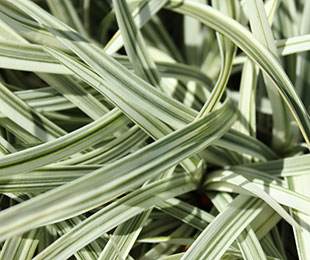
These grass-like strappy plants are ideal lawn alternatives which also work great in mass plantings. Use different liriope varieties to contrast colours and sizes for maximum effect.
Silverlawn™ Liriope muscari ‘LIRSS’ PBR has white and green variegation on its leaves, which appear silver from afar. Contrast these plants with other varieties for visual appeal.
https://www.ozbreed.com.au/plant-ranges/strappy-leaf-plants/silverlawn-liriope/
Agapanthus

These plants seem to have fallen out of fashion in certain crowds, but that’s a shame because they’re incredible plants that can give temperate regions like Melbourne tropical vibes with their lush, juicy foliage and vibrant blooms.
Bingo Blue™ Agapanthus hybrid ‘ANDbin’ PBR is a compact form with repeat flowering typically occurring each season. Just make sure to remove dead heads after each blooming flush finishes.
https://www.ozbreed.com.au/plant-ranges/hardy-exotic-range/bingo-blue-agapanthus/
Basic Principles for Mass Planting
Now that you have a quality plant list for mass planting, let’s revisit some of the basic principles for specifying plants. It may be some time since you studied this stuff, so please take this opportunity for a refresher.
- Climate Considerations: Understand the climate and microclimates of the specific location before selecting plants that are well-suited to the specific conditions, including temperature, rainfall, soil type and sunlight exposure.
- Plant Selection: Prioritise quality varieties for mass planting that will promote biodiversity, support local ecosystems, and reduce maintenance requirements, while displaying superior establishment rates. These plants may be slightly more expensive up-front, but they will save the end client money because there will be fewer plant deaths. Specifying quality plants can lead to more work from happy clients.
- Soil Analysis: Conduct a thorough soil analysis to determine soil quality, pH levels, and drainage characteristics to ensure plants selected for mass planting will thrive in the given soil conditions. If there isn’t budget for a proper soil analysis, you should at least have a qualified horticulturist come and have a look because they can at least tell you what sort of texture you have, whether it’s heavy, loamy or free-draining.
- Maintenance Requirements: Consider the maintenance needs of the selected plants, including watering, pruning, fertilising, and pest control, to create a sustainable and manageable landscape design. Fast-growing plants will require more pruning, while slow-growing plants require less pruning.
- Seasonal Variation: Factor in seasonal changes and plan for year-round interest by selecting plants that offer blooms, foliage colour variations, or textural elements in different seasons to maintain visual appeal throughout the year.
- Spacing and Planting Density: Determine appropriate spacing and planting density for mass plantings based on the growth habits and mature sizes of the selected plant species to avoid overcrowding and ensure optimal growth. You can over-plant tubestock to fill gaps as they grow, and then have the maintenance crew thin out individual plants as their foliage starts to touch.
- Design Impact: Evaluate the visual impact and overall design goals of the mass planting scheme to create focal points, define boundaries, or enhance specific areas within the landscape design effectively. Consider low-lying ground covers like scaevola, contrasted with the upright architectural foliage and flower spikes of kangaroo paws. Alternatively, opt for multiple different coloured flowering varieties of the same species.
- Water Efficiency: Incorporate water-efficient plant species and consider irrigation systems to promote water conservation and sustainability in mass planting designs, especially in regions prone to drought. On the other hand, wet-feet tolerant plants are advised for depressed areas that take longer to dry out after rain events.
- Complementary Plant Pairings: Explore plant combinations that complement each other in terms of colour, texture, height, and blooming cycles to create dynamic and visually appealing mass planting arrangements.
- Community and Stakeholder Engagement: Involve community stakeholders or clients in the plant selection process to align with their preferences, promote local biodiversity awareness, and foster a sense of ownership and pride in the landscape design.
- Combination of Plants and Features: Achieve mass by combining plants, structures, and garden ornaments strategically to create balance and visual interest in the design.
- Consistency and Repetition: Maintain consistency in plant placement, spacing, and incorporate mass groupings with repeating plant groupings to establish a cohesive and unified look in the landscape.
- Evaluation of Landscape Role: Evaluate the role of mass plantings in your landscape to ensure they draw the eye effectively and contribute to a naturalistic ambiance.

